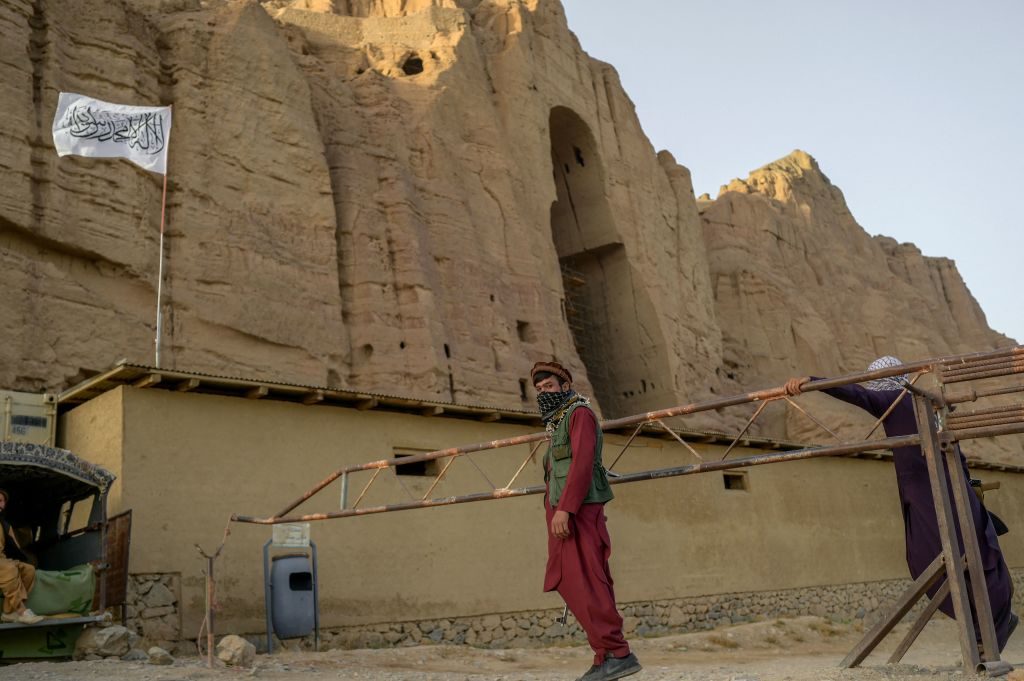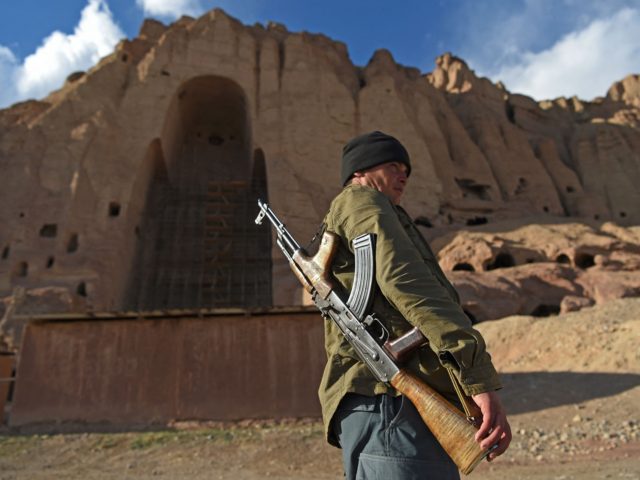A video published by Afghan media on Monday appears to show Taliban jihadists shooting at the remains of the Bamiyan Buddha statues, once the world’s tallest but bombed into oblivion by the Taliban during its previous rule in 2001.
The video surfaced less than a month after Agence France-Presse (AFP) reported that the jihadist organization, now in control of all of Afghanistan, had stationed gunmen at the Bamiyan historic site to protect antiquities. On August 16, the day after the former government of Afghanistan collapsed and yielded to the current Taliban regime, a Sri Lankan newspaper published assurances from a Taliban spokesman that the terrorists would not harm Buddhist holy sites.
“Buddhist sites in Afghanistan are not at risk, I refute any claim in this regard,” spokesman Suhail Shaheen told Sri Lanka’s Daily Mirror.
The images of individuals opening fire on the side of the mountain that once preserved the Bamiyan Buddha statues surfaced via the Afghan newspaper EtilaatRoz and appeared to be verified by New York Times reported Sharif Hassan. EtilaatRoz sourced the video to a local resident, stating that “residents of Bamiyan are concerned that the Taliban will once again destroy the province’s historical and cultural monuments.”
شلیک طالبان بر بودای بامیان
ویدیویی که یکی از باشندگان #بامیان به اطلاعات روز فرستاده نشان میدهد که طالبان بر بودای بامیان فیر می کنند. باشندگان بامیان ابراز نگرانی میکنند که طالبان دوباره آثار تاریخی-فرهنگی این ولایت را تخریب کنند. pic.twitter.com/OiMwURpJVP
— اطلاعات روز | Etilaatroz (@Etilaatroz) November 1, 2021
The videos appear to have been filmed from too far away to gauge the damage that the jihadis had caused to the site. They appeared to be shooting into the now-empty holes on the side of the mountain that held the Buddhas.
The Taliban used dynamite to blow up the largest Bamiyan Buddha in 2001. At the time, the United Nations historical preservation agency UNESCO had not labeled it a World Heritage Site, making it difficult for the U.N. to defend. Negotiations to urge the Taliban not to destroy the statues failed. The statues were believed to have been carved in the Sixth Century, but archaeologists knew little more about them when discovered. Their destruction resulted in the revelation of other archaeological finds hidden on the side of their mountain, including as many as 50 caves used by Buddhist monks.
The Taliban is a radical Sunni jihadist organization that considers the depiction of any deity an affront to Islam. Destroying the Buddhas was part of a larger campaign to eradicate iconography that hurt their Islamic sentiments. The former Afghan government, though also nominally Islamic, attempted in March to pay homage to the destroyed artifacts with a 3D projection of the statues back into their places.
“We do not want people to forget what a horrific crime was committed here,” Zahra Hussaini, one of the organizers of the event, told the BBC.
Taliban jihadists seized control of Afghanistan on August 15, after a successful campaign of conquest that began in response to President Joe Biden extending the 20-year Afghan War through that month. In response to the Taliban’s return to power, UNESCO Director-General Audrey Azoulay issued a statement urging the Taliban to allow “the preservation of Afghanistan’s cultural heritage in its diversity, in full respect of international law” and to work to “spare and protect cultural heritage from damage and looting.”
UNESCO had invested $20 million in a museum at the site.
The Taliban indicated last month that it aspired to protect what remained of the Bamiyan archaeological site. The AFP reported seeing Taliban “gunmen” guarding the site and claimed one jihadi did not “hide his embarrassment” when asked about the destruction there.

Members of Taliban stand guard in front of the site where the Salsal Buddha statue once stood before being destroyed by the Taliban in March 2001, in Bamiyan province on October 2, 2021. (BULENT KILIC/AFP via Getty Images)
“I really can’t comment … but what is certain is that now we are committed to protecting the historical heritage of our country. It is our responsibility,” the jihadi, identified as Saifurrahman Mohammadi, told AFP. Mohammedi confirmed AFP reporting that Taliban jihadis had looted the site en masse following August 15, but insisted that the looting “was before [the Taliban’s] arrival.”
The Taliban’s typical ruthless brutality – in addition to destroying ancient treasures, the jihadists presided over a reign of terror defined by gross human rights abuses, including attacks on women and violence against all non-Muslims – has become a hindrance for the group during its second stint in power. The World Bank and International Monetary Fund (IMF) have frozen Afghan government assets and the Afghan Central Bank has similarly blocked the jihadists from accessing government money. In response, Taliban spokesmen have gone on a global campaign to urge the world to fund their success.
“We are freedom-fighters of Afghanistan like your ancestors who struggled for liberation of your country. But we are victims of poisonous propaganda,” spokesman Shaheen told Sri Lanka’s Daily Mirror in the same article in which he vowed that the jihadists would protect Buddhist sites. Taliban jihadists have not abstained from asking the United States, with whom they were at war for the last 20 years, for money.
“America is a big country, they need to have a big heart,” acting Taliban “Foreign Minister” Amir Khan Muttaqi said in September.
Ahmad Wali Haqmal, a spokesman for the Taliban’s “finance ministry,” expressed more desperation last week.
“The money belongs to the Afghan nation. Just give us our own money,” Haqmal demanded, addressing the international finance institutions that had frozen the group out.
Follow Frances Martel on Facebook and Twitter.

COMMENTS
Please let us know if you're having issues with commenting.